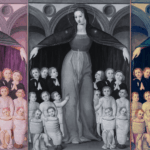John Grisham’s debut was hatched early in his law career. A desire to improve his skills as a litigator prompted him to watch the docket for lawyers known for their legal prowess. Whenever possible, he attended criminal trials to observe and learn.
One such case was that of a white man on trial for the rape of a twelve-year-old black girl. The day the plaintiff testified, the judge, citing the girl’s age and the sensitive nature of the testimony, cleared the courtroom allowing only the jury, the defendant, the attorneys, and essential staff to remain.
As an officer of the court, Grisham could observe. Except for the defendant, there wasn’t a dry eye in the courtroom while the young girl described the harrowing account of her violent rape. When the judge called for a recess, Grisham hurried through a back door, down a set of stairs and into the parking lot only to realize he’d forgotten his briefcase.
He retraced his steps to find the courtroom empty except for the accused who sat alone at the defense table, and a deputy who stood nearby. As he observed the scene, Grisham imagines the victim’s father a mere ten feet from his daughter’s assailant, contemplating the overwhelming chances for his acquittal in the then racially biased state of Mississippi.
An onslaught of questions struck like a lightning bolt. What if the father had a gun in his pocket? What would happen if he were to kill the man who had so brutally raped his little girl? What would be the outcome of a trial if this father did what everyone on the jury and in the courtroom surely had thought themselves?
He began to imagine a courtroom drama in a small southern town that examined the justification for a father’s revenge as told through the eyes of a young lawyer such as himself. The ever-powerful “what if” questions swirled, and if his mind is anything like mine, they didn’t let go until he began to write. John Grisham left the courtroom that day and began to consider those questions. The answers, of course, became the story for his stunning debut, A Time To Kill.
As described in his book, On Writing, Stephen King describes the inspiration that formed the foundation for his debut novel, Carrie, as a “collision of ideas.” It began oddly enough during a summer job as he scrubbed rust stains from the walls of the girls’ showers at the local high school.
Pink shower curtains hung from chrome rings providing privacy the boys’ showers didn’t have. Then he saw something else the boys’ locker room didn’t have—white metal boxes attached to the wall that dispensed feminine hygiene products. It sparked an idea.
He envisions teenage girls showering without the privacy of curtains, then imagines that one such girl begins her first period but doesn’t know what it is. The girl sees blood puddling at her feet, feels the intense cramping in her abdomen, and as she thinks she might be dying, she begins to scream. Girls gather to watch the spectacle. Recognizing her confusion and naivety, they cruelly taunt her. He wonders if, or even how, she fights back.
Later he recalls a LIFE magazine article he’d read about telekinesis—the ability to move objects with your mind. The article suggested that young people might have these powers, especially adolescent girls at the time of their first menstrual cycle. And wham. What would happen if this beleaguered young girl discovered she had extraordinary superpowers?
Thinking about the novel’s spectacular conclusion makes me shiver. Yet, it had been a series of unrelated ideas, a naïve young woman, bullying, and telekinetic powers that came together to create the seed that developed into the narrative for Stephen King’s blockbuster novel, Carrie.
The inspiration for my lead detective, Andrea Stuart, came to me in a dream. I sense your skepticism, but I’ll tell you anyway. I’d been working on the second novel in a mystery series for the middle grade reader when I began to think about a series for an adult audience.
I wondered who my main protagonist would be. A woman, certainly. And a detective. But an unlikely detective. Never in a million years would this woman have considered a career in law enforcement. And if that was so, how would this career come to be? Then I had the dream. Three times.
In the short, vivid dream, I watch as a woman, early twenties, mascara smeared beneath her haunted eyes, pushes through a heavy, thick-glassed door. The dream returns the following night and, as the door swings open, I see the reflection of sunlight on her forehead, and the rough gray concrete of an exterior wall reminiscent of some sort of municipal building.
On the third night, the sequence repeats, except this time I watch as she walks away from the building. That’s when I notice the red soles of her expensive high-heeled shoes. I’m wide awake and wondering, who the hell is this woman? Is that a police station she’s leaving? And if so, why had she been there?
I turn on the light and jot the details in the notebook I keep on the bedside table. In the days that follow, my fears subside and I dismiss the irrational thoughts of friends and relatives whispering about the sad state of my perpetually loose screws. The simple explanation is that my brain is working overtime to answer the question I’d posed and been unable to answer: Who would my protagonist be?
The dream never returns, but my questions multiply and the answers become the beginnings of a character profile for Andrea Stuart, the main protagonist of my debut novel, The Lost Hours. I have a partial profile, yes, but no story. I know she’s from a well-to-do family, that she’s damaged, it’s something she can’t or won’t share with her family or even a friend, and that she was never supposed to be a cop, but not much more.
Many weeks later, I’m fascinated by a disturbing story dominating the news. It’s hard not to gawk when the headlines involve the very rich perpetrating unconscionable acts. It makes me wonder what would compel someone who wants for nothing to behave in a manner that risks their family, their wealth, their freedom.
Just like that, my ideas coalesce; I have an unlikely main protagonist, know her backstory, and why she gave up higher education and, to some extent, her comfortable, privileged life to become a cop. I know who my antagonist is and what compels them to commit the unthinkable. It thrills me to imagine pitting one against the other.
The artistic mind works in a myriad of ways, but when the questions come, pay attention. The answers may very well be the seed of an idea that ignites the imagination and, when expanded upon, forms the basis of a narrative, even, as in my case, when you’re safely tucked beneath soft sheets.
***
















